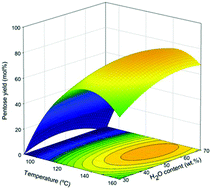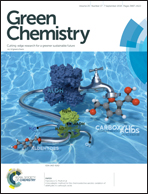Biorefinery approach for lignocellulosic biomass valorisation with an acidic ionic liquid†
Abstract
The commercialisation of the biorefinery approach involving the integration of the multi-step valorisation of low value biomass feedstock into a variety of chemicals, fuels and bioproducts is still very limited. In this context, the present work proposes an advanced methodology that comprises a cascaded approach towards wheat straw valorisation. The studied concept lies in the employment of an aqueous solution of the acidic 1-ethyl-3-methylimidazolium hydrogen sulfate ionic liquid in a selective and efficient hydrolysis of the hemicellulose fraction of wheat straw into pentoses, namely xylose and arabinose. An experimental design was utilised to search for the optimisation parameters, resulting in a maximum 80.5 wt% pentose yield in the liquor. Furthermore, the remaining solid, which contained practically all of the initial cellulose and lignin, was processed by considering two scenarios: (i) a direct enzymatic hydrolysis of the reaction solid, which yielded 75.8 mol% glucose; or (ii) a preceding extraction of lignin followed by enzymatic saccharification of the cellulose pulp, which yielded 91.3 mol% glucose. For both scenarios, lignin-rich solid fractions were obtained with distinct purities and yields. Additionally, the second scenario allowed producing a stream of value-added aromatic (phenolic) compounds. This work also overcame the challenges in IL recycling and reuse, with a simultaneous recovery of the pentoses from the reaction liquor as high as 88.6 mol%.



 Please wait while we load your content...
Please wait while we load your content...